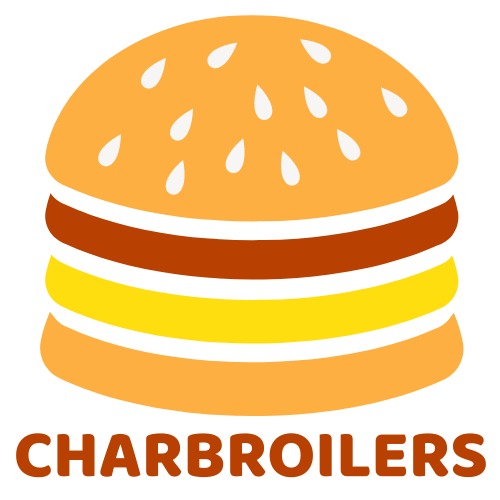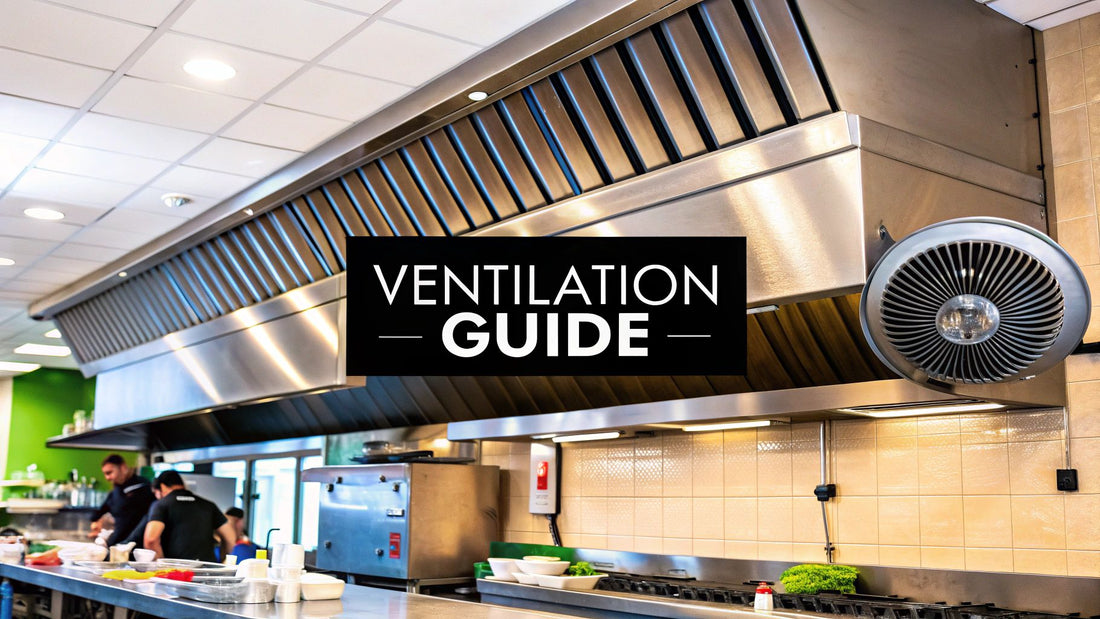
Your Guide to Commercial Kitchen Ventilation Requirements
Share
Stepping into the world of commercial kitchens means getting serious about one thing right away: commercial kitchen ventilation requirements. These aren't just helpful suggestions; they're strict codes and local laws built to stop fires, keep your staff safe, and ensure your kitchen can legally operate. Think of your ventilation system as the unsung hero of your restaurant, silently pulling dangerous heat, smoke, and grease away from your cooking line.
Why Kitchen Ventilation Requirements Are Non-Negotiable
A commercial kitchen's ventilation system is its set of lungs. Just like you can't work without breathing clean air, a kitchen simply can't function safely or efficiently without a powerful system pulling out the bad air and bringing in fresh air. This constant airflow is the bedrock of kitchen safety.
The number one priority is fire prevention. High-heat cooking, especially with appliances that produce a lot of grease, sends greasy vapor into the air. Without a proper ventilation system, that grease builds up inside your ductwork, creating a highly flammable fuel source just waiting for a spark to ignite it. A compliant system captures and removes these dangerous vapors before they ever become a serious risk.
A system that meets code is an engineered network of parts all working together. Getting a handle on these components is the first step toward building a safe and compliant kitchen.
Core Components of a Compliant Ventilation System
A compliant ventilation system is far more than just a fan in the ceiling; it's a precisely engineered system where every part has a critical job. The table below breaks down the key players and their roles in keeping your kitchen safe and up to code.
| Component | Primary Function | Key Requirement |
|---|---|---|
| Exhaust Hood | Captures heat, steam, and grease directly at the source over cooking equipment. | Must be sized correctly (typically extending 6" beyond the equipment) and be a Type I hood for grease-producing appliances. |
| Ductwork | Transports contaminated air from the hood safely out of the building. | Must be made of continuously welded steel, fully sealed to prevent grease leaks, and installed with proper clearance from combustibles. |
| Exhaust Fan | Creates the powerful suction needed to pull air through the hood and ducts. | Sized to provide the correct CFM (Cubic Feet per Minute) airflow for the equipment load and duct run. |
| Makeup Air (MUA) Unit | Replaces the air being exhausted to maintain neutral air pressure in the kitchen. | Must supply approximately 80-90% of the air being exhausted to prevent back-drafting and other pressure issues. |
Understanding how these parts work in tandem is crucial. A powerful exhaust fan is useless without a well-designed hood to capture vapors, and the entire system will fail without a makeup air unit to replace the air being removed.
These systems are a major business investment, and the global market reflects their importance. It was valued at USD 4.30 billion in 2024 and is expected to climb to USD 6.82 billion by 2032. With North America leading the charge due to strict safety codes, it's clear that robust air management is a top priority for any serious foodservice business.
Meeting these regulations isn't just about passing an inspection. It's about protecting your investment, your people, and your customers. A single fire or a failed health inspection can shut a business down for good.
At the end of the day, every piece of equipment on your cook line contributes to the ventilation load. Heavy-duty appliances that pump out a lot of smoke and grease are the main focus of these codes. If you're outfitting your kitchen, our guide on commercial fryers can help you understand how different equipment choices impact your ventilation needs. Getting your ventilation right from the start is the foundation for a safe, clean, and successful restaurant.
Choosing the Right Commercial Kitchen Hood
The exhaust hood is the single most important piece of your kitchen's ventilation system. It’s your frontline defense, the primary capture point for all the heat, smoke, and grease-filled vapors your cooking line produces. Think of it as the tireless guardian protecting your entire kitchen environment.
But picking the right one isn't a one-size-fits-all deal. It's a critical decision that directly impacts the safety of your staff, your compliance with health and fire codes, and the overall air quality in your restaurant. Making the wrong choice is like trying to put out a grease fire with a squirt gun—it's just not going to work. Your first and most important step is understanding the two fundamental categories of hoods.
Type I vs. Type II Hoods: The Core Distinction
The kind of cooking you do is what dictates your hood choice. It’s that simple. Commercial kitchen hoods are split into two main types, each engineered to handle very different things.
-
Type I Hoods (Grease Hoods): These are the heavy hitters of the kitchen. A Type I hood is mandatory for any appliance that kicks out grease and smoke. We're talking about charbroilers, griddles, fryers, and ranges. They are built with special grease filters designed to trap those flammable particles, stopping them from getting into the ductwork where they could become a serious fire hazard.
-
Type II Hoods (Condensate Hoods): These hoods are designed for heat and moisture, not grease. You’ll find them over appliances like steamers, certain ovens that don't produce grease, and commercial dishwashers. A Type II hood is there to capture and get rid of steam and heat, which makes the kitchen a much more comfortable place to work, but it doesn't have the essential grease-trapping filters of a Type I system.
Choosing between them isn't optional. Putting a Type II hood over a charbroiler is a direct violation of fire codes like NFPA 96 and a surefire way to fail your next inspection.
The image below breaks down this hierarchy perfectly, showing exactly where each hood type belongs in a professional kitchen.
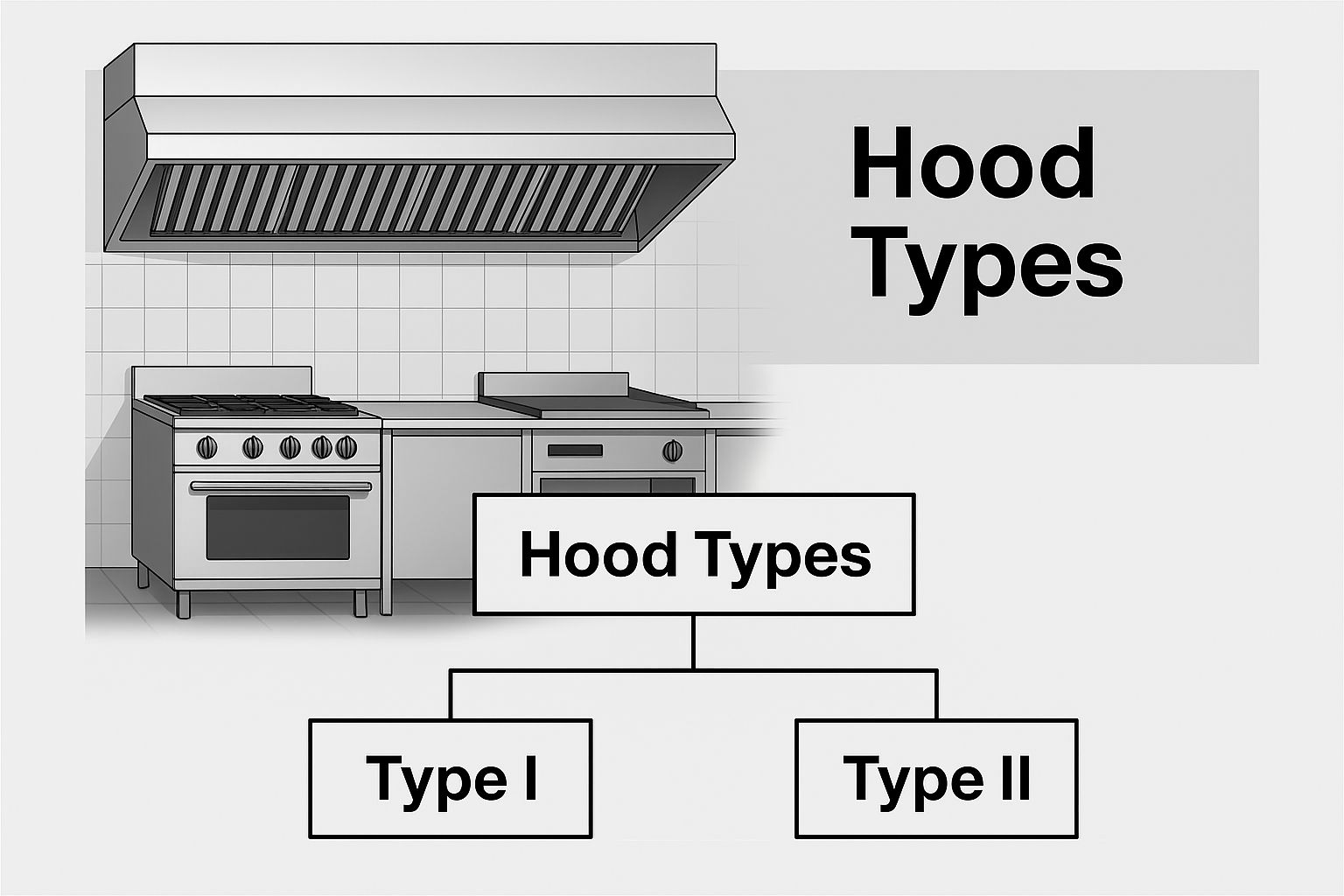
As you can see, the Type I hood sits directly over the high-heat, grease-producing equipment. This highlights its role as the number one safety component for any kitchen that cooks with fire and fat.
Matching the Hood Style to Your Kitchen Layout
Once you've settled on Type I or Type II, you need to pick a physical style that fits your kitchen's floor plan. The right style ensures that all the smoke, steam, and grease is captured efficiently instead of escaping into your kitchen.
Wall-Mounted Canopy Hoods These are the most common style you'll see. They are mounted flat against a wall, right over a line of cooking equipment. They do a great job of creating a contained capture zone, making them very effective and straightforward to install.
Island Canopy Hoods If you have a cooking island in the middle of your kitchen, you’ll need an island hood. These are much larger and more complex because they have to capture vapors from all four sides. This means they need a more powerful exhaust fan to pull everything in properly.
Choosing the right hood is more than just checking a box for the inspector. It’s a direct investment in the safety of your people and the long-term health of your business. A properly selected and installed hood is your best defense against a devastating kitchen fire.
Ultimately, the equipment you use will always be the deciding factor. Take our lineup of commercial charbroilers—whether infrared, gas, or electric, they all produce significant grease and smoke and absolutely require a robust Type I hood. The same goes if your menu features a lot of fried items or seared dishes made on commercial hot plates. A Type I hood is non-negotiable. The more grease and smoke an appliance generates, the more critical your hood selection becomes.
Calculating Your Kitchen's Airflow Needs
Airflow is the powerhouse behind your ventilation system, measured in Cubic Feet per Minute (CFM). Think of it as the sheer volume of air your exhaust fan can yank out of the kitchen every single minute. Getting this number right isn't just a good idea—it's one of the most critical parts of meeting commercial kitchen ventilation requirements.
Imagine trying to bail water out of a sinking boat with a teacup. If water is rushing in from a huge hole, you’ll never keep up. It's the same story in your kitchen. An exhaust fan with a low CFM rating simply can't handle the tidal wave of smoke, heat, and grease pouring off a busy commercial cook line. This isn't just inefficient; it's a fast track to a dangerous kitchen and a failed inspection.
Why You Can't Just Guess Your CFM
Figuring out your kitchen's required CFM is a precise science, not a back-of-the-napkin guess. It’s a specific calculation that HVAC pros and kitchen designers rely on to make sure the system is both safe and compliant. A handful of key factors directly shape that final CFM number, making every kitchen's ventilation recipe unique.
A system that’s too weak will fail to grab all the gunk, leading to miserable air quality and a dangerous film of grease on every surface. On the flip side, a system that's way too powerful will bleed you dry on energy costs, drive up utility bills, and could even create annoying drafts and a noisy work environment. The goal is to find that perfect sweet spot.
The CFM calculation is where the engineering of ventilation science meets the reality of your menu and kitchen layout. A miscalculation here can undermine your entire investment in a safe and functional kitchen.
Key Factors That Determine Airflow Needs
So, what exactly goes into calculating this all-important number? It’s not just one thing. Professionals look at a combination of your equipment, your hood, and your kitchen's layout. Each piece adds another layer to the puzzle, ensuring the final system is perfectly dialed in for your specific operation.
The three big variables are:
- The Type of Cooking Equipment: Different appliances cook differently and produce vastly different amounts of heat and smoke.
- The Duty Level of Your Equipment: This is a simple way to classify appliances as light, medium, heavy, or extra-heavy duty.
- The Size and Style of Your Hood: The physical dimensions of the hood itself are a fundamental part of the math.
Let's break down how these moving parts fit together.
The Role of Cooking Equipment
The single biggest driver of your CFM requirement is what's sitting under the hood. It’s simple, really. An electric steamer (light-duty) has a completely different ventilation need than a bank of deep fryers (heavy-duty).
Appliances that kick out a ton of grease and smoke demand much higher exhaust rates. For instance, our selection of commercial charbroilers is a perfect example of this. We offer a wide selection of commercial charbroilers for your restaurant, including infrared, gas, and electric char broilers. All these units are considered extra-heavy-duty. They produce intense, searing heat and a massive volume of smoke and grease, requiring a beast of an exhaust system with a high CFM rating to keep your kitchen safe and clear.
Here’s a quick look at how equipment duty levels stack up:
| Duty Level | Example Appliances | Impact on CFM |
|---|---|---|
| Light-Duty | Ovens, steamers, pasta cookers | Requires the lowest CFM |
| Medium-Duty | Griddles, electric ranges | Requires a moderate CFM |
| Heavy-Duty | Gas ranges, deep fat fryers | Requires a high CFM |
| Extra-Heavy-Duty | Charbroilers (all types), woks | Requires the highest possible CFM |
This is exactly why any good ventilation specialist will start by asking for a complete list of your cooking equipment. Your menu dictates your equipment, and your equipment dictates your airflow. It's a chain reaction that starts the second you decide to put that perfectly grilled steak on the menu.
The Critical Role of Makeup Air
Have you ever tried to pull open a restaurant's front door, only to feel like you're in a tug-of-war with a vacuum? That's not your imagination. It's the most common sign of a kitchen gasping for air—a problem caused by a lack of makeup air.
When your powerful exhaust hood yanks smoke, grease, and heat out of the kitchen, it creates a void. Physics demands that air be replaced. If you don't provide a path for new air to get in, you create negative air pressure. This turns your entire building into a giant vacuum cleaner, desperately trying to suck air in from wherever it can. This is precisely why makeup air is a non-negotiable part of any modern commercial kitchen.
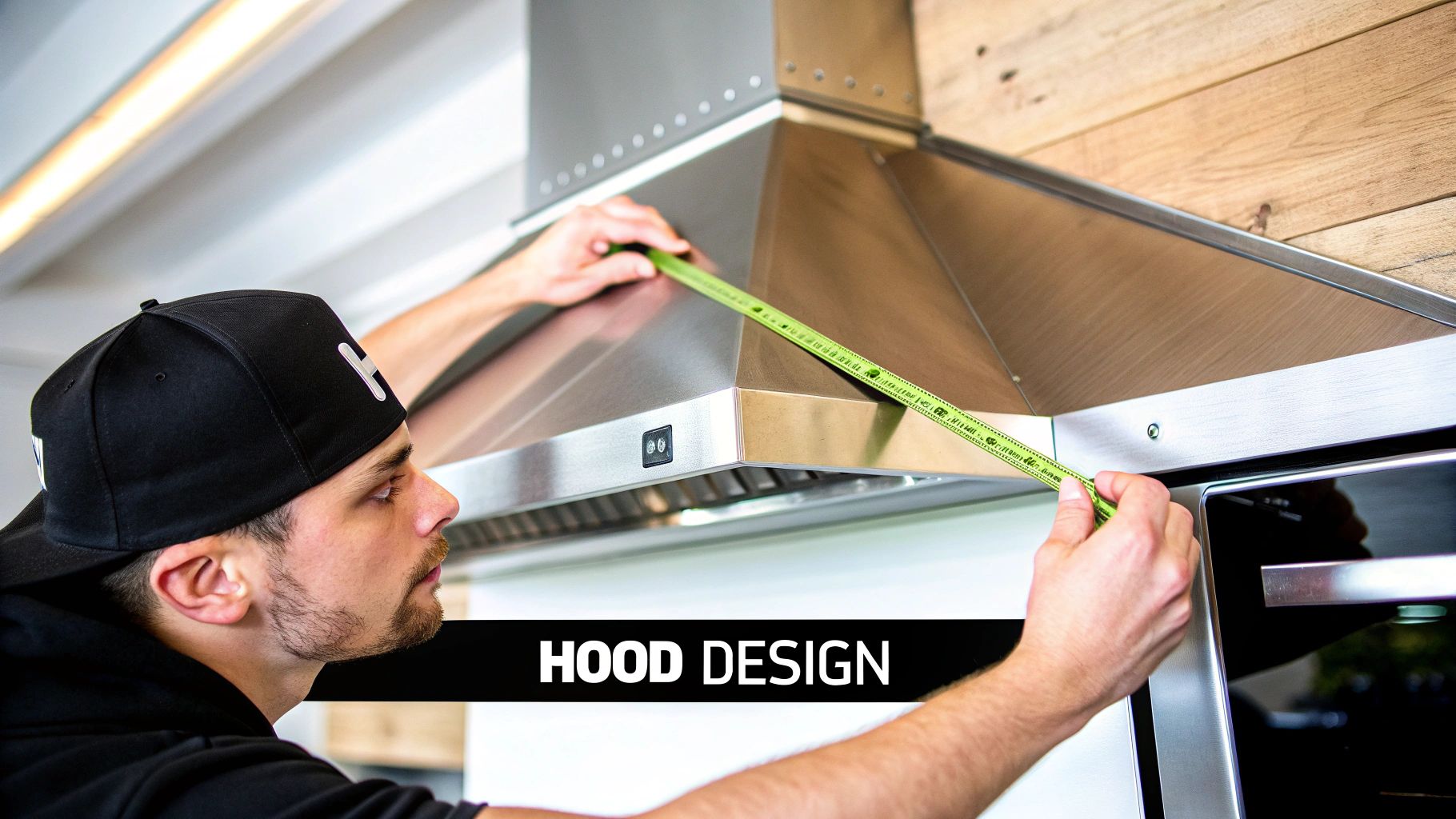
Think of it like pouring water from a bottle. You can't get a smooth flow out unless you let air flow back in to replace it. Try to block the opening, and the water just sputters and glugs. Your kitchen's ventilation system works the same way; the exhaust fan can only do its job if a fresh supply of air is provided to "make up" for what's being removed.
Why Air Balance Is a Code Requirement
This isn't just about making the front door easier to open. Building codes like the International Mechanical Code (IMC) are crystal clear on this, often mandating that kitchens replace nearly 100% of exhausted air. It's a critical safety standard designed to prevent the serious problems caused by negative pressure.
When a kitchen is "starved" for air, it will pull that replacement air from anywhere it can find an opening. This leads to a whole host of issues:
- Back-Drafting: This is the most dangerous consequence. The vacuum effect can actually pull deadly carbon monoxide from gas-fired water heaters or ovens back into the kitchen instead of letting it vent safely outside.
- Poor Hood Performance: Your expensive Type I hood is rendered useless. Without enough incoming air to flow into the hood, smoke and grease just spill out into the kitchen, defeating the entire purpose of your ventilation system.
- Unpleasant Drafts: Air will scream in through every crack and crevice, creating cold, annoying drafts for customers in the dining room.
- Odors and Temperature Chaos: With air infiltrating from all directions, controlling your restaurant's temperature becomes a nightmare, and kitchen odors get pulled straight into dining areas.
The only professional solution is a dedicated Makeup Air (MUA) unit. This is specialized equipment designed to pull fresh air from outdoors, filter it, and introduce it into the kitchen in a controlled way. It restores the balance, making sure every other system in your building can work the way it was designed to.
Tempered vs. Untempered Makeup Air
So, you know you need to bring in fresh air, but what kind? The choice between introducing air at its natural outdoor temperature or treating it first is a huge decision that affects both your staff's comfort and your energy bills.
Untempered MUA Units This is the most basic system. It’s essentially a fan in a box that pulls outside air directly into the kitchen without heating or cooling it. While it's the cheaper option upfront, it can create a miserable working environment. Imagine blasting 10°F winter air or 95°F summer air directly into your kitchen. It’s not a recipe for happy, productive employees.
Tempered MUA Units A tempered unit is the smarter, more sophisticated solution. It conditions the incoming air before it enters your kitchen.
- Heated Makeup Air: A must-have in colder climates. These units use gas or electric heaters to warm the incoming air to a comfortable temperature. This eliminates icy drafts, protects pipes from freezing, and makes the kitchen a much more pleasant place to work.
- Cooled Makeup Air: A lifesaver in hot climates. Some MUA units can cool the incoming air, taking a massive load off your building's main AC system and preventing the kitchen from turning into an unbearable sauna.
While an untempered system looks like a way to save a few bucks, a tempered MUA unit is almost always the better long-term investment. The upfront cost is higher, but you get that money back through better energy management, improved employee morale, and a kitchen that actually runs efficiently.
For kitchens using high-heat equipment like our powerful gas charbroilers, managing the environment is non-negotiable. The intense heat from these units already puts your HVAC system to the test. A tempered MUA unit helps by ensuring the replacement air isn't fighting your efforts to keep the kitchen functional. Whether you choose from our wide selection of infrared, gas, or electric char broilers, making sure your MUA system can keep up is fundamental to a safe and successful operation.
Meeting Code with Proper Installation
Let’s be honest. You can spend a fortune on a state-of-the-art ventilation system, but if it’s put together wrong, you’ve just bought a very expensive, very dangerous hunk of metal. Proper installation is the final, make-or-break step that turns all that equipment into a fire-safe, compliant system that will breeze through any inspection.
This is absolutely not a DIY weekend project. Getting commercial kitchen ventilation right demands a deep understanding of complex codes and precision that only comes with experience. The entire process hangs on hiring certified professionals who live and breathe fire safety standards, especially NFPA 96, which is the bible for ventilation control and fire protection.
Think of these pros as the conductors of an orchestra. They make sure every piece—from the hood above your cook line to the exhaust fan on the roof—works in perfect harmony. An amateur job almost always leads to failed inspections, expensive tear-outs, and a much higher risk of a devastating kitchen fire.
Non-Negotiable Installation Practices
A compliant installation isn’t about suggestions; it’s about following a strict set of rules designed to contain grease and stop fire in its tracks. There’s zero room for shortcuts. A professional’s goal is to build a sealed, tough-as-nails system that can handle the daily abuse of a commercial kitchen.
Here’s what that looks like in the real world:
- Leak-Proof Welded Ductwork: This is probably the most critical part. All ductwork for a Type I system has to be made of steel, with every seam continuously welded. If you see screws or—heaven forbid—tape, you have a massive problem. Those connections will leak grease, creating a hidden fire hazard right inside your walls and ceilings.
- Smart Fan Placement: The exhaust fan can't just be slapped anywhere on the roof. It needs to be installed with safe and easy access for the constant cleaning, maintenance, and repairs it will need. This means proper clearance from roofing materials and installing an NFPA 96-compliant hinge kit on upblast fans so technicians can clean underneath them safely.
- Correct Hood Overhang: The hood must hang over your cooking equipment by at least six inches on all sides. This isn’t for looks; it creates a vital capture zone. This overhang ensures every bit of heat, smoke, and greasy vapor gets pulled into the system instead of spilling out into your kitchen and creating a mess.
The Mandatory Role of Fire Suppression
For any kitchen using a Type I hood—which is pretty much every commercial cooking operation—an integrated fire suppression system is not a feature. It’s the law. This system is your last line of defense when a grease fire erupts.
It’s an automated network of nozzles built right into your hood and ductwork. The second it detects a fire, it blasts a fire-retardant chemical agent to smother the flames.
A professional installer doesn't just hang the nozzles. They ensure the fire suppression system is perfectly integrated with your kitchen's utilities. This means connecting it to a gas shut-off valve that instantly kills the fuel to your appliances and an electrical shunt trip that cuts power to the exhaust fan, so it doesn't fan the flames.
This work must be done by a licensed fire protection company. They calculate the precise nozzle placement to guarantee full coverage for every piece of cooking equipment under the hood. After they're done, the system has to be tested and certified before you can legally open for business.
How Your Charbroiler Dictates Installation Needs
The type of cooking equipment you use directly shapes how rigorous the installation needs to be. High-grease appliances, like charbroilers, demand the absolute toughest safety measures. Our huge selection of commercial charbroilers is the perfect example of equipment that requires this top-tier level of installation care.
Whether you're looking at our powerful infrared, versatile gas, or efficient electric char broilers, these units are all classified as extra-heavy-duty. They pump out a serious volume of grease and smoke. That means every part of the installation—the welded ducts, the powerful exhaust fan, and the perfectly tuned fire suppression system—has to be flawless. It's not just about meeting code; it's about running a safe operation.
Your Essential Maintenance Checklist
Think of your ventilation system as more than just a piece of equipment. It’s a major investment in your restaurant's safety and your ability to stay in business—and just like any other high-value asset, it needs regular attention. Neglecting it isn't an option.
Maintenance isn't a chore; it’s the best insurance policy you can have for your kitchen. It’s your frontline defense against devastating grease fires, embarrassing health inspection failures, and surprise equipment breakdowns that can shut your doors without any warning.
Let's walk through a practical playbook for keeping your system in top shape. A clean, well-maintained system doesn't just run better and last longer—it keeps your staff, your customers, and your property safe. Sticking to a consistent schedule is how you meet your commercial kitchen ventilation requirements and protect that investment.
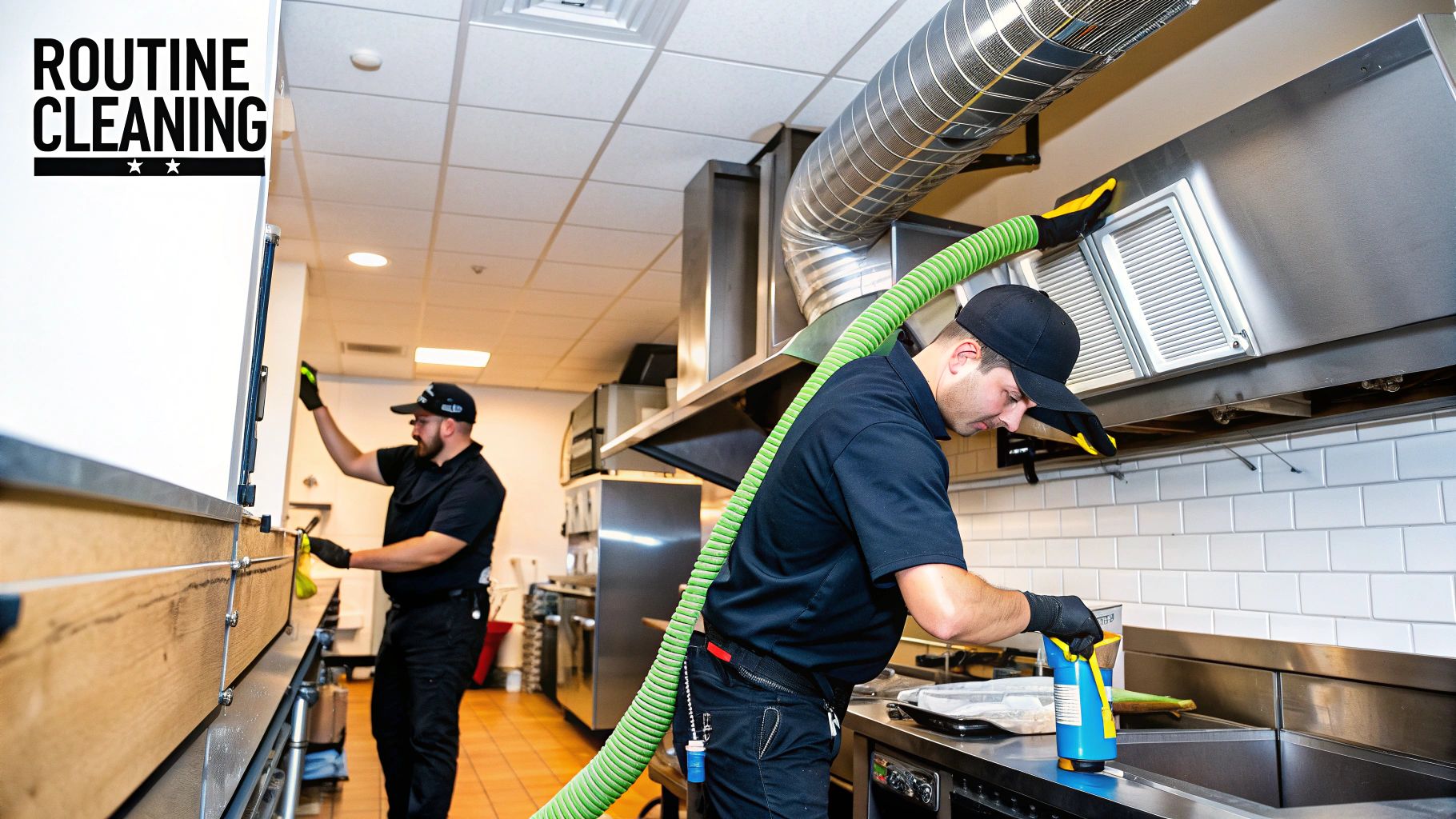
Legally Mandated Professional Cleaning
First things first: some maintenance jobs aren't just a good idea, they are legally required by fire codes like NFPA 96. The big one is professional hood and duct cleaning. This isn't a DIY job—it requires certified technicians who have the right tools and training to scrub the entire system, from the filters you see every day all the way to the exhaust fan hidden on your roof.
How often you need this service depends entirely on what you’re cooking and how much of it you’re cooking.
- Monthly: This is for kitchens using solid fuel, like wood-fired pizza ovens or charcoal charbroilers. The buildup is fast and serious.
- Quarterly: Required for any high-volume spot. Think 24-hour diners, places that do a lot of deep-frying, or kitchens using high-grease equipment like commercial charbroilers. Our wide selection of infrared, gas, and electric charbroilers for your restaurant fall into this category.
- Semi-Annually: This is the standard schedule for most traditional sit-down restaurants with a moderate cooking volume.
- Annually: This applies to low-volume kitchens, such as those in churches, day camps, or businesses that only operate seasonally.
Falling behind on this schedule is a direct code violation. If a fire ever breaks out, you can bet the first thing fire marshals and insurance investigators will ask for is proof of professional cleaning. Don't get caught without it.
Your In-House Maintenance Checklist
While you leave the deep cleaning to the pros, your kitchen crew plays a vital role in the system's daily health. Consistent in-house checks and cleaning tasks are what stop grease from building up to dangerous levels and help you catch small issues before they snowball into expensive disasters.
Daily Tasks (At the End of Every Shift)
- Clean Hood Filters: Pop out all the grease baffle filters and give them a good cleaning. A soak in hot, soapy water usually does the trick. Clean filters are your first and best line of defense.
- Wipe Down Hood Surfaces: Clean the inside and outside surfaces of the hood canopy. This quick wipe-down prevents that sticky, grimy buildup.
Weekly Tasks
- Inspect Fan Belts: Take a look at the exhaust fan belt. You're searching for cracks, fraying, or any signs of wear. A snapped belt will shut down your cook line instantly.
- Listen for Trouble: Pay attention to the sounds your system makes. Any new rattling, grinding, or squealing from the exhaust fan could mean the motor bearings are on their way out.
- Clean Duct Access Panels: Wipe down the access doors on your grease ducts. This keeps them clean and ready for the professional cleaners when they arrive.
Monthly Tasks
- Inspect the Makeup Air Unit: Check the filters on your MUA unit. If they're dirty, clean or replace them. Clogged filters choke your system, restricting airflow and making it work way harder than it should.
- Verify Fan Operation: Make sure both the exhaust and makeup air fans are running smoothly. You shouldn't see any excessive vibration.
- Examine the Entire Cook Line: Your ventilation system doesn't work in a vacuum. The equipment underneath it needs care, too. Keeping everything from your fryers to your refrigerators in great shape is all part of a smart, holistic approach to kitchen management. For more on this, you can learn how to properly care for commercial refrigerators to keep them running efficiently.
Following this simple checklist will keep your system compliant, safe, and doing its job—protecting the heart of your business.
Common Questions About Kitchen Ventilation
Let's be honest, navigating the world of commercial kitchen ventilation can feel like a maze of codes, acronyms, and expensive equipment. It's totally normal to have questions. Getting clear, straightforward answers is the key to making smart decisions for your business, keeping everyone safe, and staying compliant.
Here are some of the most common issues I see restaurant owners run into.
Navigating Compliance and Costs
What Happens If I Don't Comply with Ventilation Codes? This is one area where you absolutely can't afford to cut corners. Non-compliance isn't just a slap on the wrist; it can cripple your business. You could be looking at steep fines, failed health inspections, or even a forced shutdown until your system is up to code.
Even more critically, a faulty system creates a massive fire hazard and an unsafe work environment for your team. If a fire does happen, your insurance carrier will likely deny the claim if they find your ventilation wasn't compliant. It's a risk that's just not worth taking.
How Much Does a Commercial Ventilation System Cost? That’s the million-dollar question, isn't it? The price varies dramatically depending on your kitchen's size, the kind of cooking you’re doing, and how complex your local codes are. A simple setup for a small café might only run a few thousand dollars.
On the other hand, a large, busy kitchen with a lot of heavy-duty equipment can easily top $50,000. The big cost drivers are always the size of the hood, the required CFM (airflow), and whether you need a tempered makeup air unit to heat or cool the incoming air.
Think of it this way: getting these fundamentals right empowers you to have productive conversations with contractors. It ensures you invest in a system that protects your business, your people, and your bottom line for years to come.
Equipment-Specific Ventilation Needs
Do I Need a Type I Hood for a Combi Oven or a Charbroiler? For a charbroiler, the answer is a hard yes. A Type I hood is absolutely mandatory for any charbroiler—gas, electric, or infrared. They pump out heavy grease and smoke, and you need that robust, filtered ventilation to handle it safely. From our wide selection of commercial infrared, gas, and electric charbroilers, every single one requires a Type I system to keep your restaurant safe and compliant.
With a combi oven, it’s a bit more nuanced. If you're only using it for steaming vegetables, a Type II hood might be enough. But the second you use it for roasting or cooking anything that produces grease, you’ve crossed the line. At that point, a Type I hood is required to meet code.
At Charbroilers, we know that high-performance cooking equipment is the heart and soul of your kitchen. That's why we offer a huge selection of commercial charbroilers built to meet your restaurant's toughest demands. Check out our inventory of powerful infrared, dependable gas, and efficient electric char broilers to find the perfect engine for your menu. Equip your kitchen for success by visiting us at https://charbroilers.com.
